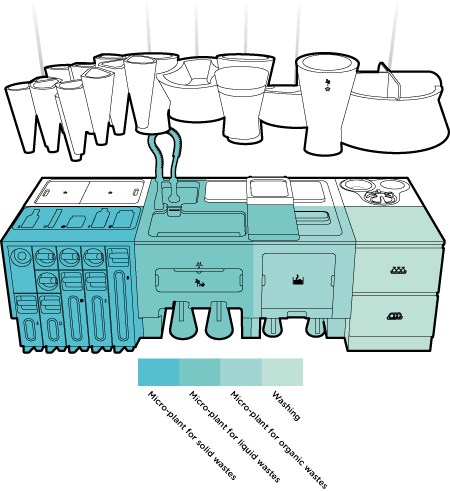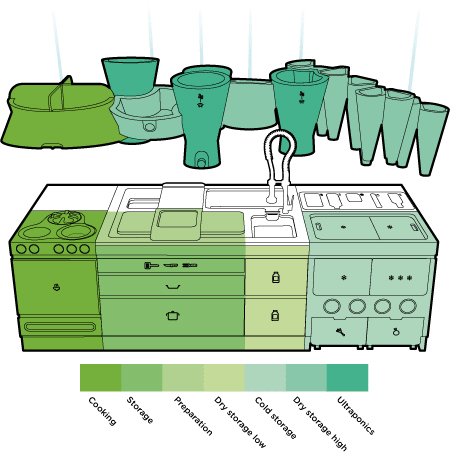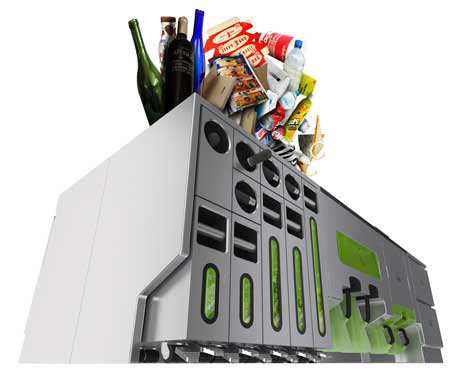
Designers Victor Massip and Laurent Lebot of Faltazi have designed a conceptual system where water is recycled and waste is broken down by worms inside the kitchen.

Called Ekokook, the project aims to process waste as close as possible to the point where it’s produced.

The design incorporates storage containers for packaging, a reservoir under the sink for collecting water to be reused and a container where earthworms break down organic waste.

See also:
Flow2 kitchen by Studio Gorm (August 2009)
Vaisselier Système D by Matière A (July 2009)
Colo dishwasher by Peter Schwartz and Helene Steiner (June 2009)
Local River by Mathieu Lehanneur (April 2008)
Ethical Kitchen by Alexandra Sten Jørgensen (August 2007)

The information below is from the designers:
–
Three built-in micro-plants for three recycling functions
The kitchen is where most household wastes are produced. If waste management is to be effective at both the individual and the collective level, selection and processing must begin as soon as the waste product appears. When we are peeling carrots, for example, we should be able to dispose of peelings straight away by emptying them into the earth worm composter direct from the work surface. Similarly, when we wash salad leaves, we should be able to choose to save the water for watering household plants. Simple actions like these must be encouraged and made easy by adequate fittings. The same goes for the disposal of solid wastes.

Micro-plant 1
Solid wastes: selecting, processing, storage.
Solid wastes have no smell. This means that they can be kept longer, once their volume has been reduced to a minimum. On the scale of the city, this enables council trucks to collect waste less frequently, which means less cost for the community, less noise nuisance, and less atmospheric pollution. We have broken down the receptacle for solid wastes into five units for processing glass, paper, plastics, metals and miscellaneous waste. The volume of each unit corresponds to dimensions that suit an average family (two adults & two children). Units can be customized to suit user profiles and to interact with services offered by the community.

We have opted for a system of components organized by bloc and by function: in the high part are different hatches, and in the lower part are the units for reducing volumes, and storage containers on rollers. The devices we propose to reduce the volume of wastes are machines activated by hand: a steel ball, like the ball in a pinball machine, to break glass, an endless screw like a nut-cracker to compress cans and water bottles, and a manual shredder-crusher to shred paper before turning it into briquettes.

Micro-plant 2
Water cycle: use, collecting, recycling.
Inspired by real-size civil engineering works for controlling water, such as locks and dykes, which move masses of water for irrigation, we have built in a double sink for retention, with an intermediate reservoir situated below the sink and two pitchers that collect kitchen water that has no grease scum. This enables users to recycle clean water by using it to water household plants. The dishwasher and steam oven can also be filled with water kept in the intermediate reservoir.

A double plug is installed in the sink bottom. The user can direct the water in the sink to its destination simply by activating one plug or the other. A filter removes particles suspended in the water to ensure that it is clean and of good quality. A simple device like this enables a saving of up to 15 litres per day, which is equivalent to what is needed to run a dishwasher load.
The entire intermediate reservoir can be lifted out to be washed, in order to meet standard hygiene norms.

Micro-plant 3
Processing & recycling organic wastes: the earth worm composter
My garbage bin is alive! As its name implies, the earth worm composter uses earth worms to break down organic wastes. All sorts of green wastes are produced in the kitchen: fruit and vegetable peelings, scrapings, left-overs, etc. This device aims at processing these wastes as close as possible to the place where they are produced – in the kitchen. Bringing real live earth worms into the kitchen calls for the design of a container to rationalize manipulation. It must be sealed, autonomous, and simple to manage. We propose a container unit in the form of a drum that rotates a notch day by day. Wastes shift gradually and as they are broken down and after three months maturing are sifted into a drawer as ‘lumbri’compost’. Liquid effluent drains into two pitchers. Diluted with ten parts water, it makes a rich liquid plant food ideal for indoor and outdoor plants.

It happened in 2010
Once upon a time some people decided to get a handle on their own future. They wanted to reducing their ecological footprint to the minimum, so in the course of the teens decade they introduced into everyday habitat efficient means for producing energy and reducing energy consumption, and for managing wastes.

Concepts of industrial symbiosis had been in everyone’s mind for some time, but the big thing was to apply them effectively in the home. Working in closed cycle mode, they felt that each waste should be turned into a new resource, that each drop of water that fell on the roof or came from a tap should be used to the utmost instead of going straight down the drain, that each watt of wind and solar power produced by the house should be valorized on the spot.

Little by little, the home of ‘Mr & Mrs Smith’, which had formerly been powered exclusively by fossil energies: coal, petroleum derivatives, gas… was becoming self-sufficient. The different functions dependent on consumption of an immaterial energy such as electricity were upgraded to hybrid input of power sources.

Wastes, which had once been evacuated and incinerated at considerable expense by the community, generating untold tons of ash and toxic gases harmful to the environment, were made subject to taxation by weight, which encouraged people to be more careful. People who were once just consumers became ‘consum’actors’, committed to changing their behaviour patterns and adopt eco-friendly habits. Once the means of taking immediate action were put within their reach, they seized hold of them and began changing things around, inventing new user protocols and spreading the good news.

Here we are in 2010
Ekokook is about implementing a global prospective research project for eco-friendly habitat in the real world: the Faltazi Lab. We are trying to answer the question of how to introduce ecological projects into the home. How to upgrade existing housing without advocating complete reconstruction. The obvious responses are those that use non-structural elements of living space (doors, windows, equipments…), which can be mass-produced industrially and are simple to install.

We focus on the material interfaces between habitat and external resources. Each wall, each balcony, each window, each door, each shutter can serve as a support for an eco-installation. Each installation in interaction with external networks (sink drain, garbage receptacle…) can be upgraded to produce an immediate eco-benefit. All the air, water, wind and sun that reach habitat must be seen as rare resources to be captured and used. Each drop of water must be collected and used to the utmost before being evacuated to external networks. Slowly but surely, the accumulated effects of these eco-benefits will change our environmental footprint for the better.

Ekokook grew out of an experimental approach based on the analysis of the nerve centre of every home: the kitchen. The place where we store food and prepare food, and produce and evacuate wastes is a vital core area for exchanges and convergences. It is also a place that generates all sorts of pollution. Which makes it the ideal focus for a study in eco-design.




所有评论